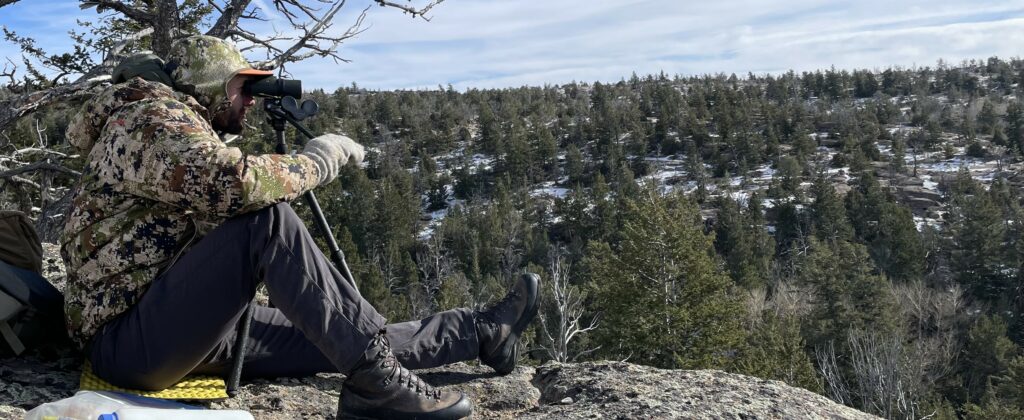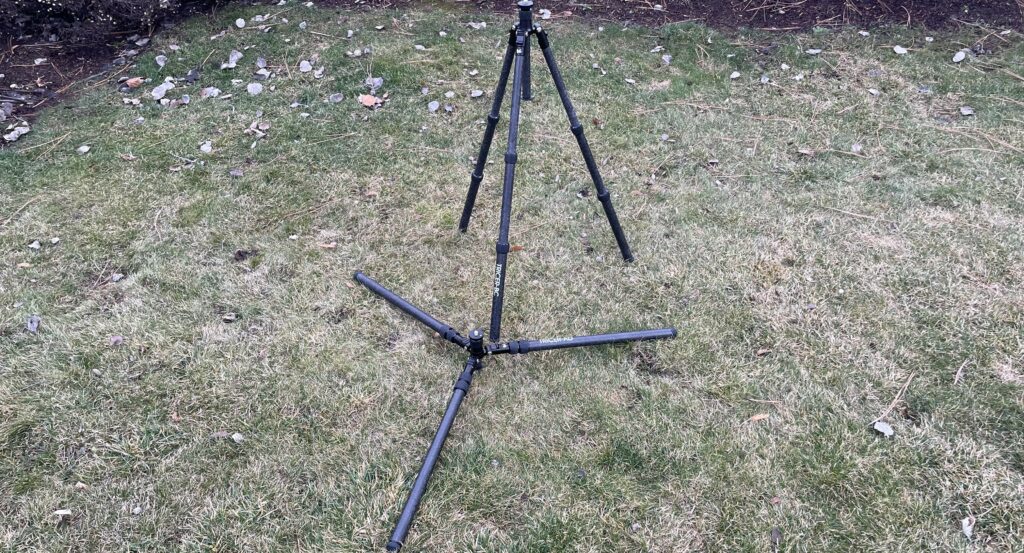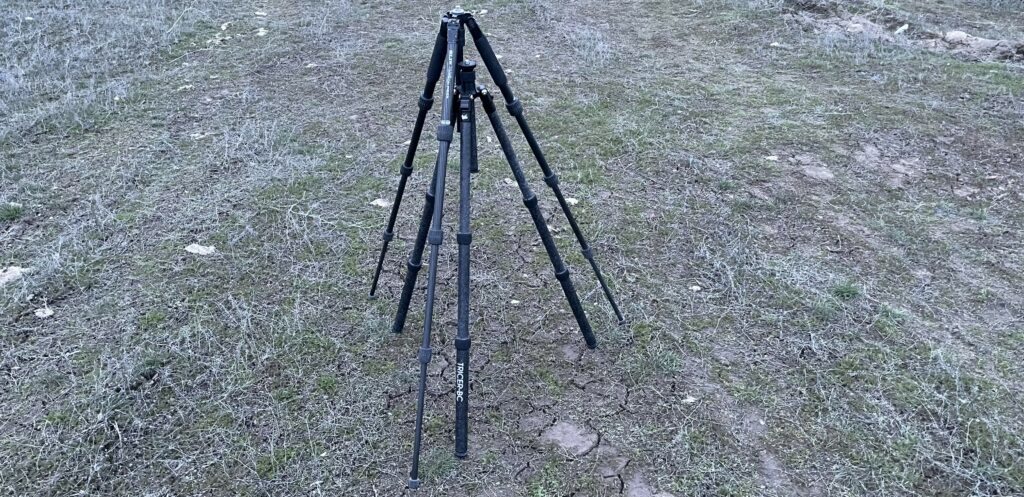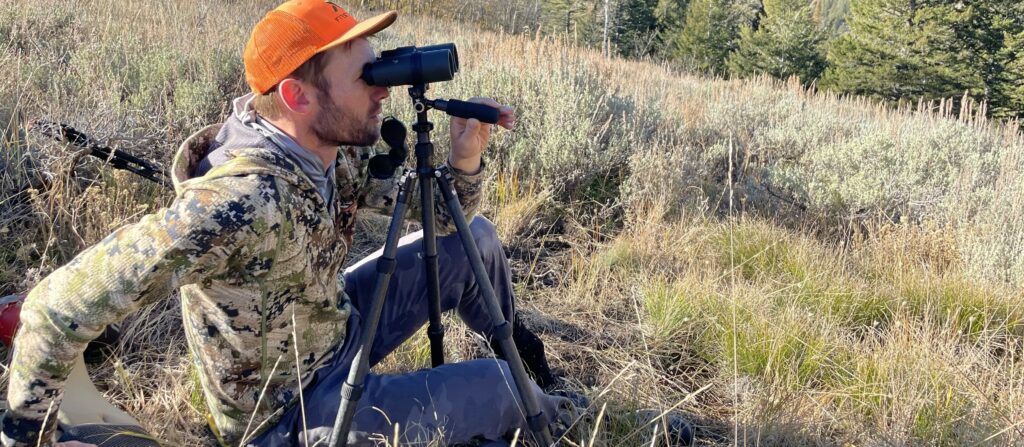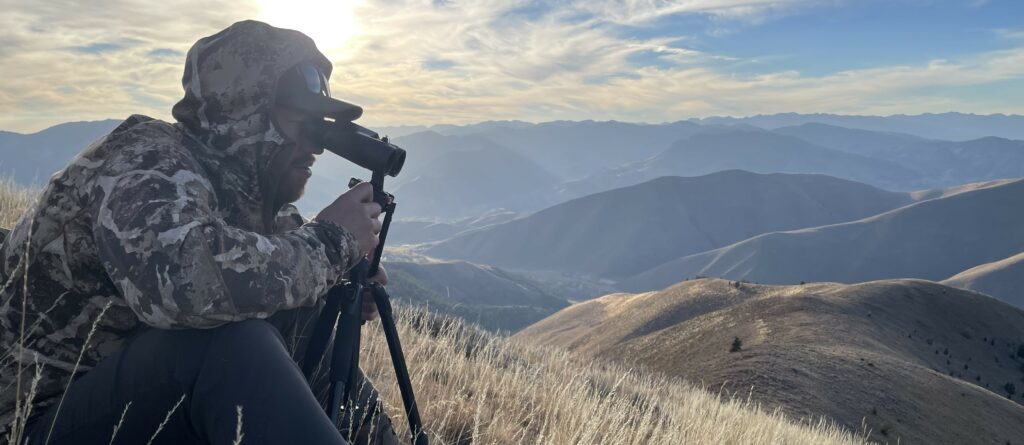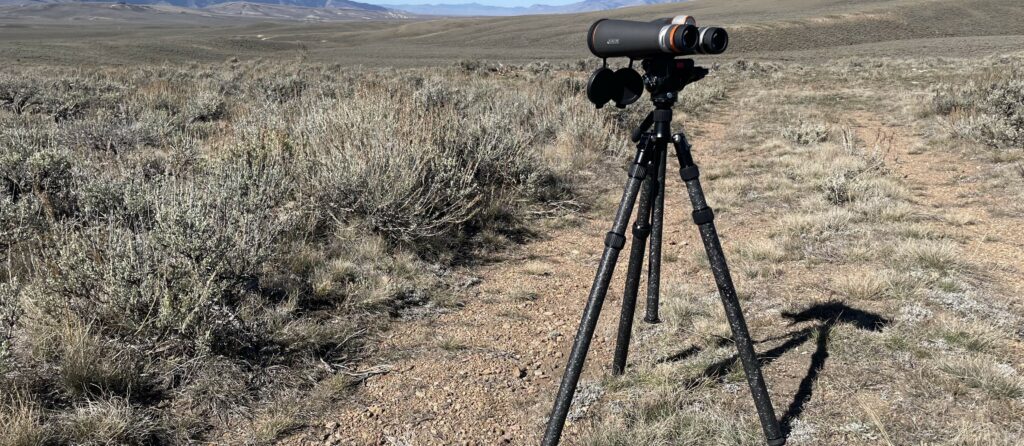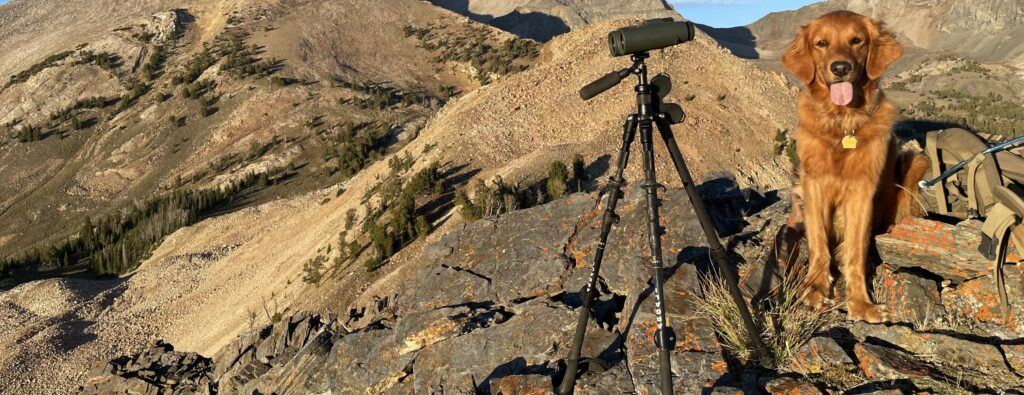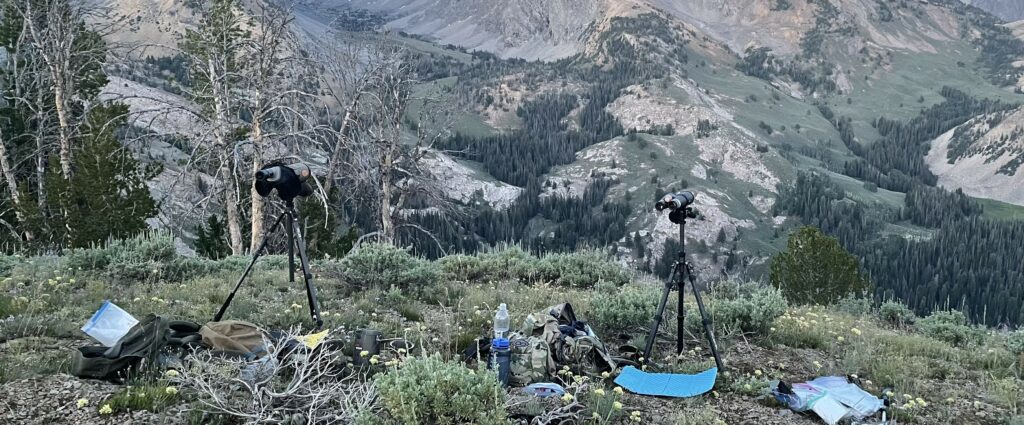I first learned about Tricer tripods several years ago when I heard founder Drew Miles on a hunting podcast describe several products they were producing for backcountry hunters, including some innovative tripod designs that utilized trekking poles for legs such as the Tricer GTP-1. That discussion piqued my interest and I have followed them ever since.
Make sure to check out our other gear reviews and the Backwoods Pursuit YouTube Channel to help you decide what gear will help you stay out in the field longer!
Last year, Tricer released two new carbon fiber tripods, the standing height Tricer-AD and the compact Tricer-BC, that appear to have a more conventional design on the surface but incorporate some features that differentiate them from the rest of the market. As an avid glasser, I was thrilled to get the opportunity to put all three tripods to the test this past season.
How They Were Tested – Tricer Tripod Review
I was fortunate to be blessed with ample hunting opportunities in 2023, including mule deer and whitetail deer hunts in Idaho, an Idaho antelope hunt, my brother’s Idaho mule deer hunt, and a Wyoming elk hunt. With a full fall schedule and multiple scouting trips planned throughout the summer, I was confident that I would have sufficient time with each tripod to figure out the pros, cons, and optimal use case for each one.
These tripods come with a 1/4″-20 or 3/8″-16 reversible stud to attach your head of choice. For variety, I tested the tripods with both the Tricer-LP pan head and the Sirui VA-5 fluid pan head. Both are light enough to utilize in the backcountry, but the Tricer-LP is an ultralight dream best suited to lightweight optics and the Sirui VA-5 is still relatively lightweight but more robust and better equipped to handle heavier glass.
I also knew it was important to test a range of optics on these tripods to get a full sense for their functionality. I utilized a Swarovski 10×42 SLCs as my primary glassing binoculars, Maven B.5 18×56 binoculars for mid-range, and a Kowa TSN-66 midsize spotting scope.
Tricer Tripod Specs
When I am in the market for a new tripod, I start by reviewing their basic specifications to ensure they will address my needs. Let’s begin with that foundation for these three Tricer tripods before diving into performance details.
| Feature | Tricer GTP-1 | Tricer-BC | Tricer-AD |
|---|---|---|---|
| Weight | 20 oz | 27 oz | 33 oz |
| Minimum Height (legs spread with short center pole / default leg position) | 18” / 28”* | 4.5” / 16” | 5” / 22” |
| Maximum Height | 64” | 40” | 64” |
| Packed length | 17” | 17” | 23” |
| Leg Sections | 4 | 3 | 3 |
| Load Capacity | Not published | 26.4 lb | 26.4 lb |
* This dimension was based on use of the Argali Carbon X trekking poles but may vary with other makes and models.
These Tricer tripods are some of the lightest options on the market for their respective intended functions.
Materials
All three Tricer tripods we tested for this review feature carbon fiber legs. Carbon fiber is dominating the high end tripod market and for good reason. Carbon fiber has an outstanding strength-to-weight ratio and is extremely rigid. This translates into legs that are able to steadily support substantial optics and minimize vibration without a significant weight penalty, which is critical for the demanding backcountry hunter.
The Tricer GTP-1 Tripod utilizes a traditional looking carbon fiber (number of layers not specified) for its one dedicated leg. The body bracket connecting the leg and the collets (used to attach trekking poles to serve as the two other legs) is made of black anodized aluminum.
Although they have different specs/dimensions, the newer Tricer-BC and Tricer-AD tripods utilize the same materials. Both tripods feature 8x (eight layer) carbon fiber construction. The carbon fiber Tricer used for these legs is visually unlike anything I have seen before, with an appearance that seems as though the various carbon fiber layers were on different orientations and ground to a smooth finish. The body bracket connecting the legs is made of black anodized aluminum.
Design
Tricer has made it their business to innovate and that is especially true with these tripods.
Tricer GTP-1
Tricer advertises the GTP-1 as the world’s lightest fully functioning sit-to-stand tripod. They accomplish this by having only one permanently attached carbon fiber leg and two additional collets that allow you to attach trekking poles to serve as the other legs. I always carry trekking poles to provide stability while hiking through rough terrain, so this design simply capitalizes on using equipment that is already with me. At only 20 ounces, it is hard to argue that this is among the lightest tripods on the market today.
Tricer-BC
The Tricer-BC represents the latest evolution in tripod design. The Tricer BC features three permanently attached legs whose sections are inverted, with the largest 1 ⅛” diameter section on the ground, a 1” middle section, and a ⅞” diameter leg at the top. Conventional tripods have the thinnest section on the ground, which potentially leads to instability at full extension. At a maximum height of only 40”, the Tricer-BC is intended for seated use only, but the incredible overall weight of only 27 oz makes this a backcountry hunter’s dream.
Tricer-AD
The Tricer-AD is the big brother of the BC. The AD utilizes the same inverted leg design for maximum stability. However, with a maximum height of 64”, not only can you glass from a seated position with ease, but you can also glass from a standing position if that is your preferred method or if low-lying vegetation dictates a more elevated platform. Although the additional height does come with a slight weight penalty, 33 oz for a full height tripod is outstanding.
Product Features
These unique tripods incorporate several features that warrant further discussion.
Legs and Angle Adjustment
The Tricer GTP-1, BC, and AD all feature carbon fiber legs, although the GTP-1 only has one dedicated leg and relies on attached trekking poles to serve as the other two legs. As described previously, the Tricer-BC and AD models utilize a unique inverted arrangement that places the largest diameter leg section at the ground to enhance stability. Legs also feature a ¼-turn twist lock to quickly set your desired length.
When the legs of these tripods are extended at their default angle, the leg platform is relatively narrow. For a fair comparison of this dimension, tripods need to be extended to the same height otherwise the taller tripods will reflect a misleading wider base leg width.
Setting all tripods at the full extended height of the Tricer-BC, the base width for each of these feature tripods (Tricer GTP-1, Tricer-BC, and Tricer-AD) is approximately 22” since they all utilize the same body bracket to connect the legs. This is narrower than the 29” provided by my tried and true Slik 624 tripod which has similar overall dimensions and intended use as the Tricer-BC.
Fortunately, they overcome this narrow stance by providing a lock at the top of each leg that allows the leg to pivot further out to two other pre-set angles for greater stability and a lower overall profile. This feature is especially helpful if you are on uneven terrain, want to shoot prone off the tripod, or want to minimize the folded length of the tripod for even more compact storage (pivoting the legs 180 degrees decreases the previously listed collapsed height by roughly 2”).


Center Post and Head Attachment
The Tricer GTP-1 tripod comes with a single 16” carbon center post and is equipped with a 3/8-16 stud to attach your head of choice. In contrast, the Tricer-BC and Tricer-AD tripods come with multiple carbon center post and stud options. The Tricer-BC comes standard with a 9” center column and hang hook that allows you to attach weight for added stability.
The Tricer-AD comes standard with a 16” center column and hang hook. The Tricer-BC and AD also come with 4” center posts that are better for shooting prone and saving weight (weights listed above are based on the standard center columns). The Tricer-BC and AD tripods also come with a ¼-20 or ⅜-16 reversible stud to accommodate almost any head on the market.
Tricer-LP Pan Head
In addition to the Sirui VA-5 fluid pan head I have used for several years, I had the opportunity to test these tripods with the ultralight Tricer-LP pan head. Coming in at only 4.5 ounces, the Tricer-LP shaves approximately 12 ounces off the already light Surui.
The Tricer-LP has a black anodized aluminum body, carbon fiber handle covered with rubber, and ⅜-16 threads to fit all standard tripods. The head also accepts Arca-Swiss mounts which have long been the standard in the photography world and are quickly gaining traction in the hunting community.
This head paired beautifully with these tripods, especially the GTP-1 and the BC, to create a true minimalist backcountry package.
What I Liked – Tricer Tripod Review
My first opportunity to extensively test the Tricer GTP-1 tripod came on an early July mule deer scouting trip in the mountains of central Idaho. My brother had secured a tag in an area we had little previous experience in, so my mission for that trip was to cover as much country as possible, dial in areas I would want to go back and spend more time in, and hopefully locate a few bucks.
At only 20 oz, and just over a pound and a half total with the Tricer-LP pan head mounted, the GTP-1 was an easy choice. With my trekking poles attached, this tripod provided great stability when glassing with a minimal weight penalty. The GTP-1 folded up compactly and was hardly noticeable in my pack.
In August, my brother joined me for a return scouting trip to that area. On that adventure, we packed the GTP-1 and the Tricer-BC to allow for a side-by-side comparison of those tripods. Although the GTP-1 had the edge in the weight category, coming in at approximately 7 ounces less than the Tricer-BC, we found ourselves gravitating more to the BC because the use of a traditional three-leg tripod has been ingrained in our minds over the past couple decades.
In early October, the taller AD finally made its debut on an Idaho antelope hunt. That tripod is functionally almost identical to the BC, although its longer leg sections provide enough height at full extension to allow glassing from a standing position. I went for a few hikes on this hunt, but the more effective strategy was to drive every road I could find, glass from nearby vantages, and then plan out a stalk once a group of antelope had been located.
The Tricer-AD proved itself valuable in this scenario because I did not have to worry about sagebrush obscuring my line of sight from a seated position. Instead, I could quickly set up the AD, scan the area from a standing position, and move on to the next vantage point if no animals were present.
Here is a summary of the things I liked about these three tripods:
Use Code “backwoods” for 10% off your next order!
- Tricer GTP-1
- Ultralight – only 20 oz
- Compact
- Tricer-BC
- Lightweight – 27 oz
- Compact
- Stable
- Tricer-AD
- Reasonably light considering height – 33 oz
- Tall enough to use while standing
- Stable
- Versatile
What I disliked – Tricer Tripod Review
The Tricer GTP-1 is a really innovative design but it does come with some downsides. First, if you hike with your trekking poles, you have to attach and detach those poles from the tripod every time you arrive at a new glassing point. That is not an arduous process, but it does require a couple extra steps that might lead to your buddy being the first to spot a buck on the far hillside.
Next, in mud or snow, you need to clean the tips of your trekking poles before they will fit inside the collets of the tripod. Another issue I found is that the collapsed length of most trekking poles is longer than the collapsed length of the one permanently attached tripod leg. This impacts the minimum height the tripod can be set up in which could potentially be an issue in certain photography scenarios or if you need to shoot off the tripod from an awkward position.
Finally, and this is going to sound obvious, but the tripod will only function if you actually have trekking poles with you to complete the second and third legs. This may seem like a no brainer, but twice on scouting trips I walked from my backcountry bivy camp to a vantage point for an evening glassing session only to discover that one of my trekking poles was back at camp propping up my shelter. This is easily remedied by temporarily removing the trekking pole from the shelter or replacing it with a stick, but it can be easy to forget until that consideration becomes part of your routine.
As mentioned previously, the Tricer-BC and Tricer-AD are very similar, differing only in height, and neither had many weaknesses. One trivial issue that took some getting used to was the twist locks between leg sections. Since the leg diameters are inverted, the ¼-turn twist locks actually tighten in the opposite direction (righty-loosey, lefty-tighty). This is not a big deal, and you quickly grow accustomed to the change, but I found myself going in the wrong direction more than once because of how customary the conventional turn direction has become.
Another feature that may be an issue for some users with all three of these tripods is that when the legs are extended at their default angle, the leg base width is relatively narrow (roughly 7” narrower than the Slik 624 which is in the same category as the Tricer-BC). A wider base width enhances stability and makes it easier to place your legs around and through the tripod when glassing from a seated position. This narrow stance can be mitigated by adjusting the lock stop at the top of the leg to another angle, but a wider starting angle would give you additional stability at the default position.
Here is a summary of the things I disliked about these three tripods:
- Tricer GTP-1
- Attach/detach trekking poles at each use to serve as legs.
- Trekking pole tips must be clean to fit in collets.
- Trekking pole legs may be longer than desired.
- Potential to forget a trekking pole.
- Leg base/platform is relatively narrow.
- Tricer-BC/AD
- Twist lock direction is unconventional.
- Leg base/platform is relatively narrow.
Manufacturing, Availability, and Affordability
Tricer is headquartered out of Alpine, CA, and although Tricer notes that their products are designed in the USA, I was unable to locate a country of origin on the tripods themselves.
Tricer offers a direct-to-consumer sales model, and their products may be purchased through their website. This approach cuts out some of the middleman markup sometimes found with tripods from other large manufacturers.
At the time of this writing, these tripods are available at the following prices: Tricer GTP-1 ($299), Tricer-BC ($339), and Tricer-AD ($349). These prices are slightly higher than some of the other tripods commonly used by backcountry hunters (Slik, Sirui, Aziak) but significantly less than premium brands like Really Right Stuff.
Customer Service and Warranty
I did not experience any issues during testing that required communication with Tricer, but they offer a 100% money-back guarantee for the first 30 days on all their products. During that window, if you are unsatisfied with your purchase for any reason (as long as the product has not been outright abused), they will issue a full refund to the original method of payment. Beyond the initial 30-day window, they offer a 1-year warranty against manufacturer defects. Shipping and handling costs are the responsibility of the purchaser.
Conclusion
Having these three Tricer tripods at my disposal over the past year afforded me the unique opportunity to test the different designs head to head in a variety of conditions. I walked away confident that each tripod has its own niche. The Tricer GTP-1 is nearly impossible to beat for the true minimalist hunter who is counting every ounce but wants the option to glass off a tripod from both sitting and standing positions. That ultralight functionality comes with compromises, though, mainly in the form of having to utilize your trekking poles for legs which may be needed for other functions.
The Tricer-AD is a great companion for someone who often hunts near roads, insists on the ability to glass from a standing position, or is looking for a single tripod to address all their needs and is willing to absorb the small weight penalty.
For me personally, I found that the Tricer-BC was ideally suited to my preferred hunt scenarios which involve packing into the backcountry and glassing from a seated position at a master vantage point for an extended period of time. The Tricer-BC combines low weight and stability in a package that functions equally well for glassing and shooting scenarios. Regardless of your style of hunting, I am confident that one of these tripods will serve you well.
Use Code “backwoods” for 10% off your next order!
Subscribe to Backwoods Pursuit to get Your FREE Backcountry Gear Worksheet!!!
Dial in your gear list, calculate your pack weight, and lighten up your pack with this handy tool!




